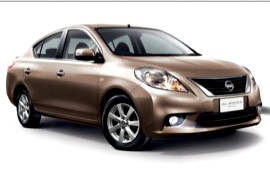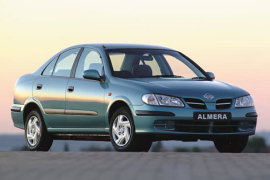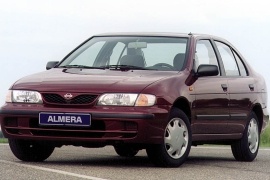NISSAN Almera / Pulsar Sedan Models/Series Timeline, Specifications & Photos
First production year: 1995
Engines: Gasoline, Diesel
Body style: Hatchback
As most of the car-manufacturers did, Nissan introduced some vehicles for specific markets such it was the case with the 2011 Almera Sedan. It was introduced for the South-East Asian market.
The Japanese car-maker was already in an alliance with Renault and the French engineers had good expertise in building cheap cars for rough roads, such as those from Thailand and the Philippines. Nissan, on the other hand, had a better reputation in that area and so, the 2011 Almera was introduced as an inexpensive family sedan.
With a design that wouldn't win any beauty contest, the 2011 Almera Sedan followed the basic lines of the Versa and Tiida. The three-box sedan shape was built for a big interior room and trunk. It looked like it was built from inside out.
Inside, the Almera Sedan offered 5 seats and enough legroom and headroom for the rear passengers. It was fitted with an AC unit and vents for the rear passengers with dedicated control for a rear ventilator. The Bluetooth connection, steering wheel controls, and power-windows were on the standard features.
The only engine available was a 1.5-liter gasoline engine mated to a standard 5-speed manual, and an option for an automatic, while the top trim level came with a standard automatic tranny. The front McPherson suspension and trailing arms in the rear were built for harsher terrain, and with a bigger ground clearance than a regular sedan.
Nissan introduced the second generation of the Almera in 2000 in three body shapes, including a four-door sedan designed in Europe and its stablemates.
Unlike its predecessor, the Almera/Pulsar's second generation was styled in Europe and followed European tastes, showing the Japanese carmaker's commitment to getting a more significant market share on the Old Continent. It used a slightly modified Nissan platform and Renault technologies.
With a design still affected by the bio-design era, the Almera/Pulsar's second-generation showed a few sharp angles that belonged to the new-edge-design rising trend. The corner-mounted turn signals featured clear lenses and yellow bulbs. It entered the competition in the compact segment, mainly against other Japanese carmakers. In the three-box sedan shape, it aimed at private customers and fleet companies as well.
Inside, the curved lines dominated the dashboard. Only the navigation screen (offered as an option) and the center vents featured squared lines. The speedometer took center stage in the instrument panel, flanked by the tachometer on the left and the fuel and coolant-temperature gauges on the right. The bucket seats were designed more for comfort and provided little bolstering. Its back seats featured a split-folding seatback and provided enough elbow and hip room but limited legroom for adult passengers. Its 393 liters (13.9 cu-ft) trunk was more than 25% smaller than the one offered by Ford Focus.
Under the hood, Nissan installed a choice of own or Renault-sourced turbo-diesel and gasoline engines. It paired them with a five-speed manual and an option for a four-speed automatic for the 1.8-liter version.
The Japanese automaker started from scratch when it developed the 1995 Almera / Pulsar, which was the replacement for the Sunny lineup.
Nissan sold the new vehicle with different nameplates depending on the market and offered it in a few shapes. While in Europe the three- and five-door hatchbacks were highly appreciated, other customers targeted the sedan version, which was considered more serious than its siblings, even though it shared many parts with the rest of the Almera range.
At the front, the sedan showed a similar front fascia as the Primera P10 generation with horizontal headlights and a small grille between them that sported the Nissan logo on its upper side. The bumper featured an additional center grille crossed by a slat extended from side to side over the fake side air intakes. The car's profile revealed a sloped rear windscreen and a tall luggage compartment. Finally, at the back, the car sported a set of wide taillights that emerged from the quarter panels to the trunk lid.
Inside, the bland design continued with a simple, curved dashboard and a low-profiled instrument cluster that hosted two larger dials for the speedometer and tachometer, plus the gauges for the fuel level and the coolant temperature. On the center stack, Nissan placed the audio system above the climate control unit. In the back, the automaker installed a bench for three, although it was mostly roomy enough just for two occupants.
Under the hood, Nissan offered the Almera with a choice of four engines paired with a standard five-speed manual transmission. The 1.6-liter gasoline unit was also available with a four-speed automatic as an option.


